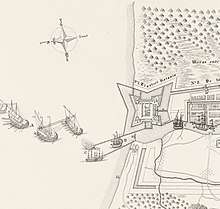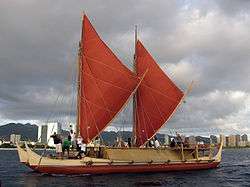Malangbang
Malangbang is a type of medieval sailing ship from Indonesia. It is mentioned in mainly in the Story of King Banjar. The name "malangbang" is considered to originate from the Old Javanese language, malabong which refers to a typical type of boat.[1] Malangbang is one of Majapahit's main naval vessel type after jong and kelulus.[2][3] Not much is known from this type of ship, apart from the fact that it also used oar beside the sails to propel it,[4][5] and was a "medium-sized" ship, between the size of jong and kelulus, larger and faster than pilang (pelang).[6]

Lambu Mangkurat of Banjarmasin used a malangbang named Si Prabayaksa to travel to Majapahit.[7][8] Quote from the Chronicle of Banjar:
He sailed in full state on board the yacht (original: malangbang) called Prabajaksa, availing himself of the insignia of royalty left by his father Ampu Jatmaka: two vertical streamers adorned with gold, two tasseled staves adorned with gold, four pennons decorated with gold paint, a braided streamer looking like a centipede embroidered with gold thread and twenty pikes with tufts of red feathers adorned with spangles of gold; his lances had biring blades inlaid with gold, their shafts where decorated with dark-red and gold paint, not to mention two state sunshades decorated with gold paint, two state lances shaped like frangipani buds, inlaid with gold and with their shafts banded with gold. The yacht was adorned with marquetry of gold; its sails were of the finest cloth; the clew-lines, the stays and the sheets were of silk and had tassels of pearls ; the rudder was of timbaga suasa (a copper and gold alloy), the oars of iron-wood with bands of gold and the anchor gear of undamascened steel. The ships sailing behind her were also fully dressed.[9]:294-297
See also
References
- Zoetmulder, P. J. (1982). Old Javanese-English dictionary. The Hague: Martinus Nijhoff. ISBN 9024761786.
- Nugroho. (2011). p. 271.
- Chronicle of the Kings of Pasai, 3: 98: After that, he is tasked by His Majesty to ready all the equipment and all weapons of war to come to that country of Pasai, about four hundred large jongs and other than that much more of malangbang and kelulus.
- Nugroho (2011). p. 299.
- Hikayat Banjar, 6.2: "And that malangbang was adorned with marquetry of gold; its sails were of the finest cloth; the clew-lines, the stays and the sheets were of silk and had tassels of pearls; the rudder was of timbaga suasa (a copper and gold alloy), the oars of iron-wood with bands of gold and the anchor gear of undamascened steel. The ships sailing behind her were also fully dressed.
- Hikayat Banjar, 1.2: "Then Ampu Djatmaka sailed with the same boat following it. Kapal and pilang are not as speedy as Si Prabayaksa; the size and the length and the ornamentation [of them] does not surpass Si Prabayaksa."
- Ras (1968), p. 292, quoting Hikayat Banjar: "Ask to repair the malangbang ship, Si Prabayaksa is the name, and that and gurap and gali, galliot and galleon, tongkang and talamba and lambu and frigate. I'm going to Majapahit seeking my dream."
- Manguin, Pierre-Yves. "Shipshape Societies: Boat Symbolism and Political Systems in Insular Southeast Asia". In Southeast Asia in the 9th to 14th Centuries, ed. David G. Marr and A. C. Milner. Singapore: Institute of Southeast Asian Studies, 1986.
- Ras, J. J., 1968, Hikayat Bandjar. A Study in Malay Historiography. The Hague (Bibliotheca Indonesica, 1)
Further reading
- Nugroho, Irawan Djoko (2011). Majapahit Peradaban Maritim. Suluh Nuswantara Bakti. ISBN 9786029346008.
- Rafiek, M. (December 2011). "Ships and Boats in the Story of King Banjar: Semantic Studies". Borneo Research Journal. 5: 187–200.


.jpg)